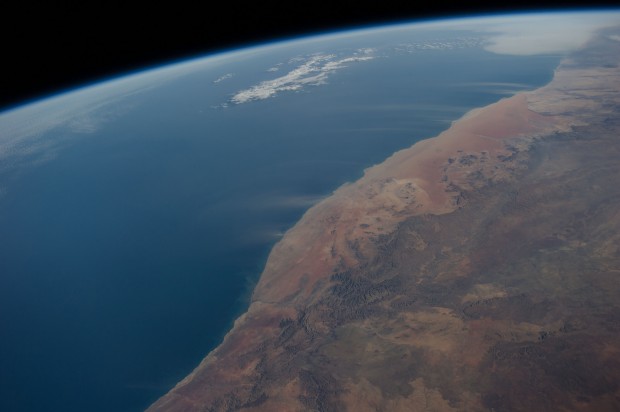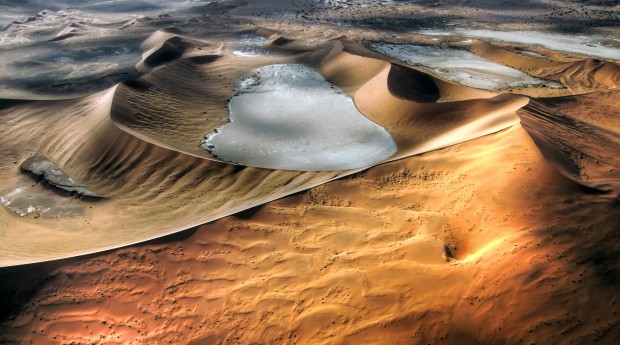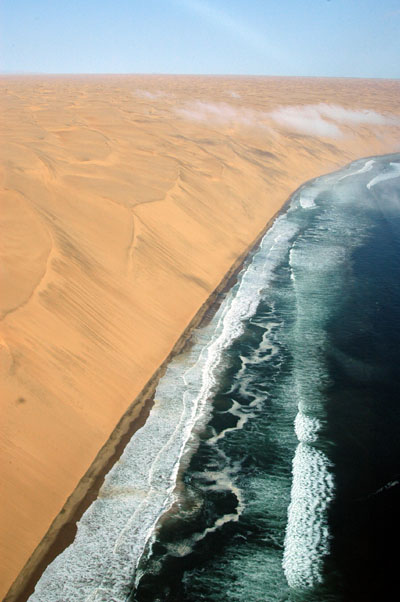The Namib Desert, meaning “vast place,” is the only coastal desert on Earth. Spanning 81,000 square kilometers, it stretches for more than 2,000 kilometers along the Atlantic coasts of Angola, Namibia, and South Africa. This desert is also the oldest desert on the planet, boasting a unique ecosystem supported by fog that provides moisture to its rare and endemic species of flora and fauna.
The Namib Sand Sea and UNESCO Recognition
In 2013, UNESCO recognized the Namib Sand Sea as a World Heritage site. This coastal desert is the only one in the world where fog sustains the environment on massive sand dunes. Some of these dunes are over 300 meters tall, and their striking formations create a mystical landscape that draws visitors and researchers alike. The fog is essential to the survival of plants and animals, making the Namib a fascinating ecological marvel.


Image by mariusz kluzniak via Flickr
The Long Wall and the Skeleton Coast
One of the most prominent coastal areas of the Namib is the Long Wall, which runs along the Sperrgebiet in southwestern Namibia. The Skeleton Coast, located along the northern part of the Namibian coast, is famous for its eerie shipwrecks. The coastline earned its name from the Dunedin Star shipwreck in 1942, immortalized in a book by John Henry Marsh. The area is now synonymous with the treacherous Atlantic waters and is a graveyard for countless ships.

By Brian McMorrow [CC-BY-SA-2.5], via Wikimedia Commons
Among the most notable wrecks is the Zeila, stranded in 2008 near Henties Bay. This coastline, though harsh, is also home to a large Cape Fur Seal colony at Cape Cross. The seals thrive along this stretch, adding a vibrant touch to the otherwise desolate environment.
Image by Jean & Nathalie via Flickr
Namib-Naukluft National Park and Sossusvlei
The Namib-Naukluft National Park is the largest game reserve in Africa, covering much of the desert. Within the park lies Sossusvlei, a breathtaking salt and clay pan surrounded by towering red dunes. The word “Sossusvlei” translates to “dead-end marsh,” a name that evokes its desolate yet beautiful atmosphere. One of the key highlights is Dune 45, an iconic red dune that offers panoramic views of the vast desert. The Deadvlei area within Sossusvlei is home to some of the oldest dead trees in the world, preserved in the arid conditions.
Image by Matt Werner via Flickr
By Ikiwaner (Own work) [GFDL 1.2], via Wikimedia Commons
Deadvlei and Sesriem Canyon
Deadvlei, meaning “dead marsh,” is a surreal white clay pan surrounded by towering red dunes, creating an otherworldly landscape. The area is home to dead acacia trees that are over 900 years old, their blackened silhouettes starkly contrasting the brilliant sand and white earth. This part of the Namib Desert is one of the most photographed areas in Namibia and a must-see for anyone visiting the region.
Image by Santiago Medem via Flickr
Close to Sossusvlei is Sesriem Canyon, a natural formation about 1 kilometer long and 30 meters deep. The canyon is narrow, with some sections only 2 meters wide, and it holds permanent water pools that provide vital hydration for the wildlife that inhabits this harsh region.
Image by Tee La Rosa via Flickr
Flora and Fauna of the Namib
Though the Namib may seem barren at first glance, it is home to several unique and fascinating species. The famous Welwitschia mirabilis, an ancient plant species that can live over 1,000 years, thrives here by absorbing moisture from the morning fog. Fog-basking beetles and geckos have also adapted to the extreme desert conditions, surviving primarily on the water provided by the fog.
Conclusion
The Namib Desert stands as one of Earth’s most extraordinary natural wonders, offering unique landscapes, rare wildlife, and a rich history of human interaction. From its towering sand dunes to the treacherous Skeleton Coast, the Namib is a desert like no other. For adventurers, photographers, and nature enthusiasts alike, the Namib is an unforgettable destination.
